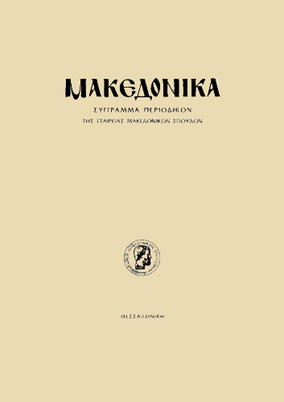Απόπειρα τοπογραφικής προσέγγισης της Θεσσαλονίκης του 1ου Μ.Χ. αιώνα
Part of : Μακεδονικά ; Vol.32, 2000, pages 59-82
Issue:
Pages:
59-82
Parallel Title:
An Attempt at a Topographical Approach to Thessaloniki of the 1st Century A.D.
Section Title:
Articles
Abstract:
In this paper we try to follow the steps of Paul in the city during his visit in 1st c. A.D. Unfortunately he left no traces behind. There are only oral tra ditions connecting him with various areas of the town (Vlatadon monastery, church of St. Georg - Rotonda). Besides, it’s rather difficult to reconstruct the town planning of Roman Thessaloniki because this is a town with a continuous historical presence on the same site for more than 2.000 years. As archaeologists believe today, the Roman city was developed following mainly the regular plan of the Hellenistic city built according to the Ippoda- mean plan. Two parallel streets run along the town in the direction east-west. They are a southern one, the Via Regia (known today as Via Egnatia) and the northern one (known today as St. Dimitrious str.). The corresponding gates for these streets in the west wall of the city are the southern Golden Gate and the northern Litean Gate. Between these two main streets is found the Hellenistic firstly and the Roman secondly Forum which consisted the cultural and reli gious center of the town. On the NW corner of it was situated the «sacred area» of the city. Unfortunately we lack any information about the area where the Romanio- te community settled, when it was organized during the 2nd c. B.C. The oldest information comes from the text of the Acts (17,1). Paul entered the city by the Litean Gate because it was the terminus of the eastern section of the Via Egnatia as it is generally accepted today. Two letters of 15th century that belong to the monastery of Dionysiou on Mount Athos give us some information about the presence of the old Jewish area near a main street as well as the existence of a church devoted to St. Paul, south of the church of St. Dimitrios. The narration of the life of St. Matrona tells us about her being the servant of a Jewish woman named Pantilli, wife of a soldier who was living near the west walls of the city and precisely near the Litean Gate because the Mithraeum which is supposed to be in the neighborhood, presupposed, the presence of Roman military forces. These information connected with the text of another letter (9th c.) who situated the Jewish area near the temple of Dio nysus lead us to the conclusion that the Jewish «synagogue» should be con sidered north of the Roman Forum, somewhere between the Litean Gate and the church of St. Dimitrios and not near the harbor as it is usually believed.Thessaloniki suffered by many disasters caused either by nature or by men. However, the numerous Byzantine and post-byzantine churches that still remain today in the city prove the accomplishement of Paul’s wish as it’s expressed in A' Thes. 1,7.
Subject:
Subject (LC):
Notes:
856:https://ejournals.epublishing.ekt.gr/index.php/makedonika/article/view/5726, DOI: https://doi.org/10.12681/makedonika.165
Electronic Resources:




